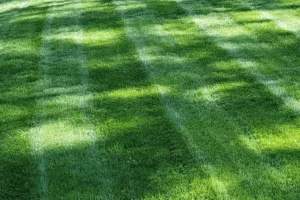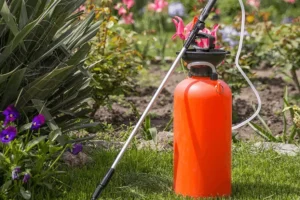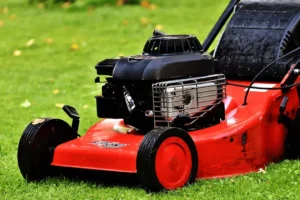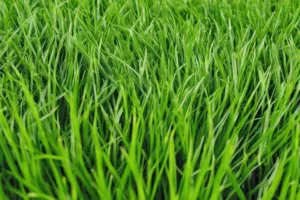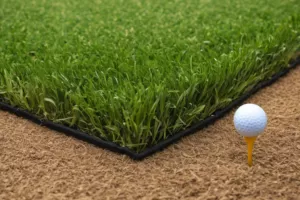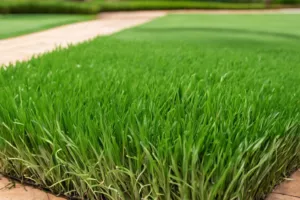
Do you want to deal with the upkeep of a natural grass lawn? Are you looking for a low-maintenance alternative that still looks great? Artificial grass could be the perfect solution for you. You’ll no longer have to worry about mowing, watering, or weeding, yet your lawn will look as lush and inviting as a real one. Proper care and maintenance allow your artificial grass to look great for years! In this article, you’ll learn the basics of synthetic grass care, from debris removal to deodorizing. You’ll be able to keep your lawn looking like new and feel proud of the beautiful outdoor space you’ve created.
Key Takeaways
- Regular cleaning and maintenance, including power washing, brushing, and debris removal, are essential for keeping artificial grass looking great.
- Replenishing infill material and deodorizing artificial grass are necessary for maintaining its natural look, feel, and smell.
- Promptly inspecting and repairing any damage caused by pets, kids, or environmental factors is crucial for the longevity of artificial grass.
- Proper water management, including good drainage and minimizing water runoff, is essential to prevent damage and maintain the health of artificial grass.
Cleaning and Maintenance
You’ll want to keep your artificial grass looking its best, so regular cleaning and maintenance is vital! Power washing is a great way to maintain your artificial grass. It will help remove any dirt and debris built up over time. If you have pets, their waste can be removed with power washing. Using a low-pressure setting is essential to avoid damaging the grass blades. After power washing, lightly spray the area with a deodorizer to ensure no odors remain.
It’s also necessary to remove any debris that may accumulate on the surface of the grass. Leaves, twigs, and other items can get stuck in the blades and must be removed. A blower or rake can help to remove the debris quickly. Additionally, if you have a pond or pool near your artificial grass, you may want to use a skimmer to remove any debris that could clog the blades.
Properly caring for your artificial grass is essential for keeping it looking great. Regular cleaning and maintenance allow you to keep your artificial grass in top condition. Plus, it’ll help maintain its lifespan so you can enjoy it for years. To preserve the integrity of your grass, it’s essential to remove any debris promptly to prevent it from clogging the blades. With proper care, you can ensure that your artificial grass looks great all year round.
Removal of Debris
Regularly removing debris is essential to keep your synthetic lawn looking its best. It would be best if you swept away any leaves, twigs, or other debris that may have collected on the surface of the artificial grass at least twice a week. This will help to keep the grass clean and free of mold and bacteria, which could lead to health risks for your family and pets. Additionally, clearing away debris can help to prevent the growth of weeds and other unwanted plants.
When removing pet waste, it’s best to do so as quickly as possible. Pet waste contains bacteria that can be harmful if left to sit on the grass, so pick it up and discard it in the trash. Consider having a designated area for pets to use the restroom on your artificial grass. This will help to keep the site cleaner and promote pet hygiene. To further protect your artificial grass from debris and mold, consider installing a doormat at the entrance of your home or a small rug at your back door. This will help to trap dirt and debris that may be tracked in from the outdoors, helping to keep your artificial grass looking its best.
Cleaning your artificial grass regularly is critical to maintaining its beauty. By periodically removing debris, preventing mold growth, and encouraging pet hygiene, you’ll be doing your part to preserve your synthetic lawn for years. You can enjoy your artificial grass for many years with a little effort and care. Let’s move on to the next step: brushing.
Brushing
Brushing your synthetic lawn regularly helps to keep it looking lush and vibrant. Regular dry brushing is an essential part of maintaining your artificial grass. It should be done weekly to remove debris, prevent moss growth, and keep the blades upright. Brushing also helps to redistribute the infill material used to help keep your lawn soft and cushiony. You can begin by using a stiff brush to brush across the surface of the grass in one direction.
Brush with each stroke in the same direction to ensure the blades stand upright. To prevent damage to the lawn, it is best to avoid using metal brushes or tools with sharp edges. The next step is to vacuum the lawn to pick up any debris, such as leaves and dirt. Cleaning the lawn can be done with a standard vacuum cleaner or a specially designed artificial grass vacuum. After vacuuming, use a leaf blower to remove any remaining debris.
The last step is to use a broom to sweep the lawn in the direction of the blades. This helps to ensure that the blades stand upright and prevents them from becoming matted down. Additionally, the broom helps to spread the infill material evenly throughout the grass, helping to keep it soft and cushiony.
Brushing your artificial grass regularly helps to keep it looking lush and vibrant. It also helps to prevent moss growth and keeps the blades standing upright. Regular dry brushing, vacuuming, and sweeping are essential to maintaining artificial grass. You can keep your synthetic lawn looking its best by following these simple steps. Keeping your synthetic lawn looking great is a great way to create a sense of belonging and satisfaction in your outdoor space.
Infill Replenishment
Over time, infill material can become displaced and require replenishment to keep your synthetic lawn looking its best. Replenishing your infill ensures your artificial grass continues to provide a lush, natural look and feel. Infill selection and quantity are both essential aspects of infill replenishment. Combining two infills, such as rubber and sand, is often recommended to provide a well-rounded look and feel.
The rubber infill helps to provide a cushion and reduces the amount of infill displacement. The sand infill helps to give the grass a more natural appearance. Regarding infill quantity, it is essential to get the balance right. Less infill will cause the grass to look and feel stiff and unnatural. Too little infill may result in a lack of cushion and a thinning of the grass blades. The amount of infill should be determined based on the type of grass and the desired aesthetic.
Taking the time to replenish your infill is essential for maintaining the longevity of your artificial grass. Please check your infill levels regularly and replace them whenever you need to. This will help ensure your artificial grass looks and feels as great as it did when you first installed it.
To sum up, replenishing your infill helps to maintain the aesthetic and longevity of your artificial grass. By selecting the right combination of infills and getting the infill quantity balance right, you can ensure your synthetic lawn looks and feels as good as it did when you first installed it. By taking the time to replenish your infill, you can keep your artificial grass looking its best for years to come. With the proper care and maintenance, your artificial grass will stay beautiful and provide a luxurious feel. Moving forward, I want you to keep your artificial grass smelling fresh by regularly deodorizing it.
Deodorizing
For a pleasant-smelling lawn, regular deodorizing is critical. Not only does it keep your synthetic grass smelling fresh and inviting, but it also helps to absorb odors and keep pests away. To ensure your artificial lawn remains deodorized and pest-free, it is essential to schedule regular deodorizing sessions. You don’t need to be a professional to deodorize your artificial grass. All you need is an excellent deodorizing product specifically designed for synthetic turf.
Before you start, carefully read and follow all instructions on the deodorizing product you are using. Once you have read the instructions, spread the product evenly and lightly over the entire surface of your artificial grass. This will not only help to absorb odors but also keep pests away. For best results, it is recommended that you deodorize your artificial grass at least once every two months.
This will ensure that your lawn remains fresh and inviting. Please also check your artificial grass regularly for any signs of damage. If you notice any damage, fixing it as soon as possible is necessary.
Deodorizing your artificial grass is essential to keeping it in top condition and ensuring it remains a pleasant and inviting space. Regular deodorizing keeps your artificial grass smelling fresh and help absorb odors, and keeps pests away. Repairing any damage to your artificial grass is also essential to maintain its appearance and ensure it lasts for years to come.
Repairing Damage
To maintain the longevity of your synthetic turf, it’s essential to regularly inspect it for any signs of damage and repair it promptly. Damage to artificial grass can be caused by things like pets, kids, or even bad weather. Fortunately, it is easy to improve synthetic turf with suitable materials. If you notice any tears in your artificial grass, the first step is mending them. You can use an adhesive that is designed for fixing synthetic turf. Gently spread the glue along the tear, using a putty knife to ensure it is evenly distributed. Once the adhesive is evenly applied, press down along the tear to ensure it is firmly adhered. Allow the glue to dry thoroughly before using the grass again.
Similarly, if you see any holes in your artificial grass, patching them is relatively simple. Depending on the size of the hole, you may be able to use a patch kit. You can cut a patch from leftover synthetic turf if the equipment is unsuitable for your hole. To attach the patch, use an adhesive designed for artificial turf. Gently spread the adhesive along the entire patch and press down firmly. Once the adhesive is fully dry, your synthetic turf should be good as new.
By regularly inspecting your artificial grass and repairing any damage, you can extend the lifespan of your synthetic turf and enjoy it for many years to come. With some care, you can ensure your fake grass looks and feels like a natural grass surface. Repairing any damage immediately will help keep your synthetic turf in top condition. To further ensure your artificial turf lasts, managing the water usage around it is essential.
Water Management
Good water management is essential for the longevity of your artificial grass. Proper drainage is critical to preventing damage from water accumulation, while minimizing runoff is necessary to conserve water and avoid soil erosion. Understanding the importance of drainage and water runoff ensures your artificial grass remains healthy and attractive for many years.
The Importance of Drainage
Without proper drainage, your artificial grass can quickly become a soggy mess – a nightmare for any homeowner. To prevent this, weeding prevention and anti-fungal treatments are essential. Not only do these help keep your grass looking lush and inviting, but they also help water drain properly. Standing water on artificial grass can lead to many problems, like damaging the turf’s backing and drowning the grass blades. Keeping up with regular maintenance can help keep your artificial grass looking and feeling its best. To keep your artificial grass looking its best, good drainage is critical. And that’s why it’s important to minimize water runoff and ensure proper drainage.
Minimizing Water Runoff
Too much water runoff can ruin your turf, so it’s essential to minimize it. You can start by selecting sealants that are pH balanced for artificial turf. This will help keep your turf in excellent condition. Additionally, sealants can provide added protection from the elements. You can choose sealants explicitly designed for artificial turf, and remember that different types of turf may require different sealants. Properly sealing your turf will protect it from water runoff and other environmental factors. Making sure your turf is well-drained is also essential for minimizing water runoff. Proper drainage will help ensure the water is not accumulating, creating a pool of water on the turf’s surface. Installing a drainage system designed for artificial turf is a great way to ensure your turf is adequately draining.
These tips help keep your turf in excellent condition and minimize water runoff. Now it’s time to focus on protecting your turf from sun damage.
Protecting from Sun Damage
You may not have considered applying sun protection to your artificial grass, but it’s an important step to help keep it looking great. Applying sunscreen to the turf is one way to protect artificial grass from sun damage. This can help keep the grass from fading in the sun. You can also cool the artificial grass using a misting system, which will help keep your turf from heating up and becoming uncomfortable.
Applying Sun Protection
Shielding your artificial grass from the sun’s rays is essential for keeping it looking lush and vibrant – don’t let it fade in the heat! Applying UV protection is vital to safeguarding your grass from the sun’s rays. You can use a UV protection spray or a coolant to reduce exposure to the sun’s heat. Apply these products in the spring and summer months to ensure maximum protection. Additionally, you can use a sunshade to keep direct sunlight off your artificial grass. These steps will help keep your artificial grass vibrant and healthy for years. With that taken care of, it’s time to focus on cooling your artificial grass and keeping it comfortable.
Cooling Artificial Grass
Now that you’ve applied sun protection to your artificial grass, it’s time to consider cooling it down. Power washing your artificial grass regularly can help keep it looking and feeling its best. Not only will it help remove dirt and debris, but it also helps to cool the grass beneath. Additionally, ice-melting products can also help to keep artificial grass cool. Sprinkling ice-melting products on your artificial grass will help to create a cooling effect that will keep it looking and feeling great all season long.
Frequently Asked Questions
How long does artificial grass typically last?
It’s no secret that artificial grass can last for a long time, though it depends on the type of turf, the amount of traffic, and how it’s cared for. Generally, you can expect your artificial grass to last 10-15 years. You should use appropriate cleaning techniques and limit its environmental impact to ensure it lasts that long. This could mean using a broom or blower to remove debris and using organic fertilizers or materials to help keep it in good condition. With the proper care, you can enjoy your artificial grass for years.
How much does artificial grass cost?
Ah, the age-old question: how much does artificial grass cost? Well, allow me to be the bearer of bad news – unfortunately, it’s not cheap. Installing costs will stack up, and don’t forget the upkeep costs, either! Are you ready to invest in high-quality grass that will make others jealous of your lawn? Then you’d better get your wallet ready! But don’t worry – it’s worth it. Investing in artificial grass means enjoying all the perks of a lush, green lawn without the hassle of mowing and weeding. So, don’t be afraid to splurge – your property will thank you.
What is the best way to keep artificial grass looking new?
Do you want your artificial grass to look fresh and new? Keeping it in top condition is easy using the proper brushing technique and cleaning solutions. First, use a stiff brush to remove any debris or dirt that’s built up. Then, mix a solution of warm water and mild soap and use a soft brush to scrub the grass. Finally, rinse off with a hose. This simple routine will ensure that your artificial grass looks great for years. Plus, you’ll be part of a community of other artificial grass owners who take pride in their lawns.
How can I tell if my artificial grass needs to be replaced?
You may be wondering if it’s time to replace your artificial grass. An adage to remember is, ‘If it ain’t broke, don’t fix it.’ It likely only needs replacing if your lawn is experiencing discoloration or drainage issues. However, if you notice your grass looks dull or faded or you’re having drainage difficulty, it’s probably time to get a new lawn. Replacing your artificial grass can be a manageable task. By researching and getting expert advice, you can find grass that fits your needs and is easy to maintain. You’ll be proud when you have a great lawn that gives your home the inviting ambiance you desire.
Can I install artificial grass myself?
Yes, you can install artificial grass yourself! All you need are some essential tools and a bit of know-how. The process is straightforward: first, you need to lay the grass down, then secure it with tape, and finally, trim it to fit. It’s a great way to save money and take control of the project. Plus, you’ll be proud of your accomplishment and feel a sense of belonging to your outdoor space. So don’t be intimidated; you can do it!
Conclusion
You’ve ended your artificial grass care journey, and your lawn looks better than ever! You’ve removed debris, brushed it, replenished the infill, deodorized it, repaired the damage, managed water, and protected it from the sun. Now your lawn looks vibrant and healthy. So, remember to keep up with regular maintenance to ensure your lawn stays in top condition – because if there’s one thing we know for sure, you don’t want your grass to look like a total mess!

Bob Green, a passionate lawn care enthusiast with over two decades of landscaping experience, is this website’s proud owner. His vast knowledge of horticulture and dedication to helping homeowners maintain beautiful lawns are reflected in the valuable content he shares on his platform. John has always been interested in Agrostology.









